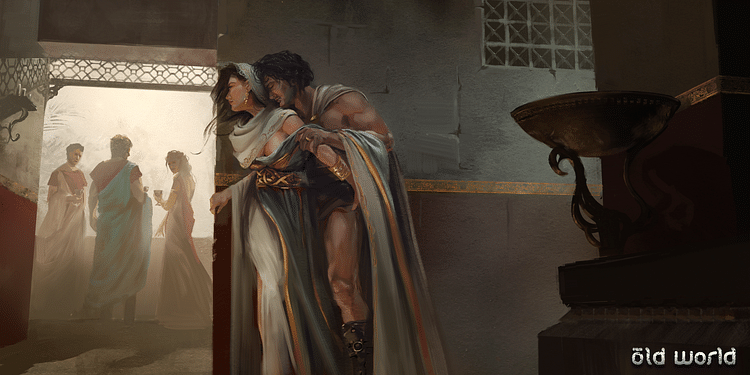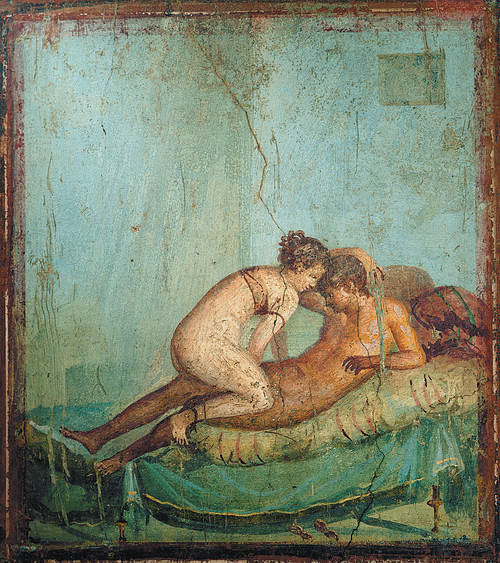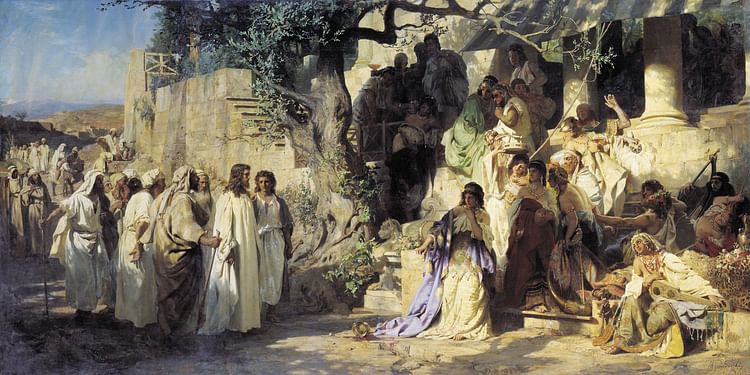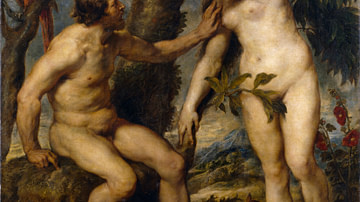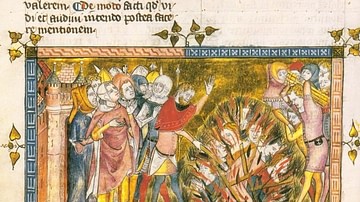The Bible is often quoted in the modern discourse concerning human sexuality, gender identification, same-sex marriages, birth control, and especially abortion. However, most modern Christian teaching evolved from the writings of the Church Fathers, a group of bishops in the 2nd century CE who created Christian dogma (a set of beliefs that everyone should follow), absorbing ideas from Judaism as well as the dominant religious culture of the Roman Empire.
Fertility & Gender Roles
In the ancient world, there was no concept of a separate category known as 'religion'; this term was only coined during the period of the Enlightenment. The divine (the powers of the universe) integrated every aspect of daily life. Ancient attitudes and views of the body were directly related to the community. In a world of harsh conditions, short life expectancy, floods, famines, high infant mortality rates, and constant wars, the eons-old concept of fertility remained crucial for survival. The community had to survive, essentially through the procreation of new humans to replace those who had died.
Behind the conviction that procreation was essential, lay the structure and order of society, particularly in the roles (and obligations) of gender. One's sex was the physical difference that one was born with; one's gender was a social construction, which differentiated men and women and organized the role and duties of each. These roles and duties had been understood as being handed down by the gods (and thus understood as religious duties) and were codified under the laws of each culture.
Every man had a religious duty to marry and produce offspring, while every woman had increased pressure on her value of reproduction, virtually the only value she brought to society. Men could rule the city and go to war to defend it, but women had only one redeeming quality – the potential for bearing children. Marriages were arranged through contracts, where women were deemed the property of men (first their father, then their husband). Hence, adultery was defined as the violation of another man's property. Ancient cultures as well as the Jewish Scriptures had a severe penalty for adultery; both the man and the woman were to be put to death. The penalty was severe because they had no DNA tests for paternity. It was crucial that it was the husband's bloodline that continued.
Because prostitutes were not parties to a legal contract, prostitution in the ancient Mediterranean was not a sin (either in the Jewish Scriptures or in the dominant society). But socially, prostitutes were at the lower end of the social scale. The ancients did not understand that semen regenerates, and they thought one should not waste it on a prostitute but use it only for the continued generations of the family.
Ancient cultures viewed miscarriages and premature births that resulted in death as grief-stricken events in the loss of a child. There were laws and degrees of punishment against anyone who caused a miscarriage. In the Jewish Scriptures, even when the miscarriage was an accident, the family had to be compensated by the offender with a fine. The books of the Prophets utilized miscarriages as metaphors; failure to obey God's commandments would result in "wombs that miscarry and breasts that are dry" (Hosea 9:14).
Birth Control, Abortion, & Abandonment
Then (as now), unwanted pregnancies were a social problem involving children born especially through the scandal of adultery. Shame was conferred upon the husband because he failed to control the behavior of his wife. Methods for dealing with unwanted pregnancy involved prophylactics (artificial tools for preventing pregnancy), surgery, drugs, potions (elixirs), and magic formulas. We have medical texts from Egypt describing formulas of paste applied to the vagina to thwart pregnancy. Just mixing up these formulas may have been a deterrent to sex; they included crocodile dung. However, the general attitude toward birth control and abortion was negative. It upended the importance of fertility and interfered with the rights of the father who was being denied descendants. It was through descendants' carrying out the funeral rituals that the memory of a person would continue to be honored. Ancient Judaism taught the preservation of all life for this reason.
Personhood in ancient Rome was not construed from the physiological aspects that began at conception or relied upon a certain amount of time in the womb. When a child was born, it was laid at the feet of the father who had the choice to pick it up and acknowledge the child as his. Providing a name at the same time conveyed the reality of existence; this person was now legal offspring, meaning that the child could inherit the father's estates. There was a tacit assumption that brothels and street prostitutes utilized various methods of abortion. This also contributed to their low social status in upending the dictates of the gods and denying the man's offspring to perpetuate his name and memory.
The practice and degree of infanticide (abandoning unwanted or disabled children) in vast numbers is largely a myth, and also mythic because the idea was rooted in the myths of various gods who were abandoned at birth, raised by someone else (usually shepherds), and ultimately recovered their standing and went on to great deeds. More commonly, unwanted children were left outside the house, where anyone could then pick them up and adopt them. We have evidence that this was a source of cheap slaves, 'rescued' in this manner. It is also a myth that daughters were abandoned more often than sons. Daughters were expensive (they required dowries in the marriage contract), but also useful for political alliances with other families. From tombstone inscriptions, we know that a daughter who died young was mourned as much as a son.
Philosophical Views
Gender roles were rationalized through the various schools of philosophy, and their analysis of medical knowledge (medicine was taught at these schools). Philosophers explained the differences between male and female. Men had hot blood, while women had cold blood. 'Hot' equated to 'active,' and 'cold' equated to 'passive.' According to medical texts of the time, during the menstrual cycle, this cold blood, affected by the vapors of the womb (and liver), could rise to the brain, resulting in 'hysteria' (the ancient concept of PMS, Pre-Menstrual Syndrome).
The womb was understood as an incubator, the sole function of which was to nurture the fetus until birth. Thus, the Latin term vagina (the "sheath to receive a sword"). It was believed that the physical traits of a person were contained solely in the semen. Women were cautioned to live healthy and passive lives during pregnancy as untoward behavior could affect the fetus. The Greek philosopher Aristotle (384-322 BCE) claimed that the birth of a girl (rather than a son), resulted from something going wrong in the womb. For Aristotle, the female was an incomplete, unformed, male fetus.
However, the activeness of men could not be given free rein, or the emotions would run amok and society would suffer from irrationality. The philosophical schools taught apatheia, not being ruled by the passions (urges) of the body or the emotions. This was especially relevant in that one moment of losing control during sexual orgasm.
Homosexuality in the Ancient World
Unlike modern debates on homosexuality, same-sex marriages, and gender identification, in the ancient world, there was no such concept as a gay lifestyle. Women in ancient Greece lived separately, in a different part of the house. This social distancing meant that close male relationships developed with other males. In Greece, the most important relationship was between an older man, a mentor, and a younger boy, past puberty but in the interim stage before adulthood. The role of the mentor was to educate the boy in the arts of governance and social rules so that the next generation could take over. Although never required, such relationships could entail emotions and physical sexual contact.
There were rules; many men publicly denied performing sodomy, defined as anal penetration. No shame was applied to the man doing the penetrating, but to the recipient. To agree to this activity conjured up a weakness, succumbing to the role of women whose job was restricted to being on the receiving end. Rather, sexual activity among men was to be done face to face, using the hands or orally.

Once the boy had achieved adult status, the relationship ended. The now-adult boy was to marry and procreate for the good of the community. An older male who continued to chase his young charge was mocked and derided by society. Our modern term, pedophilia, derives from the Greek paidós ("child") and philía ("friendly love") or ("friendship"). The purchase of prepubescent boys for sexual activity was a crime in ancient Greece and Rome.
Regarding lesbian relationships, we only have references to the famous female poet Sappho (630-570 BCE), who allegedly ran a school for young girls on the island of Lesbos. She wrote several poems with sometimes quite graphic descriptions of her love for one of her students, and lesbianism became the term for sexual relations between women.
A more definite concept is found in the book of Leviticus. Leviticus distinguishes between common sins and abominations. An abomination was a sin for which there was no atonement or rectifying the violation. In the books of the Prophets, abominations resulted in Jews being exiled from the land: "If a man lies with a male as with a woman, both have committed an abomination; they shall surely be put to death; their blood is upon them" (Leviticus 20:13). The abomination of "a male as with a woman" is driven by the waste or spilling of semen (the source of life) that could not result in procreation (the first commandment of God). Lesbianism is not mentioned because it did not involve semen.
The Books of the Prophets & the Gospels
The prophets of Israel had explained that God permitted foreign nations to conquer Israel in the past because Israel permitted idolatry to continue in the land. Idolatry involved fertility deities, so the prophets utilized metaphors of marriage and adultery in their descriptions. Such worship led to sexual immorality (Greek: pornea). Originally denoting degrees of kinship for incest codes, the prophets expanded the idea to critique native and non-Jewish lifestyles. In their view, idolatry led to sexual immorality, which led to death (the violence of the conquests).
The gospels (written between 70-100 CE) record no specific teachings of Jesus Christ on human sexuality. However, the writers claim that he upheld the traditional Jewish importance of marriage and procreation:
But at the beginning of creation God made them male and female. For this reason, a man will leave his father and mother and be united to his wife, and the two will become one flesh ... Therefore, what God has joined together, let no one separate (Mark 10:7-9).
The gospel claim that Jesus was against divorce (which Paul had claimed) was not against divorce per se (Moses had permitted it). It was directed against remarriages, especially widows. Paul the Apostle had taught that widows should remain widows because of 'the impending crisis' (the imminence of the return of Christ and the kingdom of God).
Matthew expanded the teaching:
It has been said, "anyone who divorces his wife must give her a certificate of divorce." But I tell you that anyone who divorces his wife, except for sexual immorality, makes her the victim of adultery, and anyone who marries a divorced woman commits adultery. (5:31-32).
Matthew 22:30 added: "At the resurrection people will neither marry nor be given in marriage; they will be like the angels in heaven." The later Church Fathers utilized this passage for the validation of the celibacy of the clergy. Celibacy (no marriage contract) and chastity (no sexual intercourse) were the tools applied to elevate the clergy above everyone else. It became deemed a living sacrifice in devotion to the Church, which later deemed these leaders martyrs and eventually saints.
Views of Native Lifestyles
After Alexander the Great (r. 336-323 BCE) conquered the region, some Jews created vice lists to critique the dominant Greek culture. We find a typical vice list in Paul's first letter to the Corinthians:
Or do you not know that wrongdoers will not inherit the kingdom of God? Do not be deceived: Neither the sexually immoral nor idolaters nor adulterers nor men who have sex with men nor thieves nor the greedy nor drunkards nor slanderers nor swindlers will inherit the kingdom of God. (6:9-10)
The only time that women were specifically mentioned in relation to such behavior is in Paul's letter to the Romans:
Because of this [idolatry], God gave them over to shameful lusts. Even their women exchanged natural sexual relations for unnatural ones. In the same way the men also abandoned natural relations with women and were inflamed with lust for one another. Men committed shameful acts with other men and received in themselves the due penalty for their error. (1:26-27).
These passages were applied by the later Church Fathers to condemn all homosexuality as leading to the "due penalty," Hell.
The Church Fathers
By the 2nd century CE, Christian communities for the most part no longer had Jewish members but were largely converted Gentiles. The leaders were educated in the various schools of philosophy and absorbed the view that the act of sexual intercourse, although necessary for procreation, nevertheless was a shameful act. Cultural misogynistic views of women were applied by both the Jewish Rabbis and Christians. Both reached back to Genesis to explain the fall from the Garden of Eden. This is the origin of Satan; the serpent, originally a mere plot device to explain why Adam and Eve sinned, was now reinterpreted to be the Devil.
The 2nd century CE saw the earliest Christian iconography of this being. Pan, an ancient fertility deity of the forests, was half-man, half-goat. Utilizing this image is when the Devil acquired his hooves and horns. As a fertility deity, Pan consistently attempted to seduce nymphs (lower, nature divinities). Pan was often portrayed with a huge, erect phallus. With his phallus, the Devil seduced Eve who then seduced Adam. Yes, God's first commandment had been to be fruitful and multiply, but originally, it was to be done without seduction, without involving the passions. What Eve introduced with the passions was now deemed lust (defined as a strong sexual desire). Lust was declared a sin by Christians. Augustine of Hippo would add additional details to this Christian concept of human sexuality as sin in the 5th century. He claimed that this first lustful act of Adam and Eve, the original sin, left an indelible stain on the fetus that all humans inherited.
Tertullian (115-220 CE) upheld the connection with the Devil through all women:
And do you not know that you are Eve? God’s sentence hangs still over all your sex and his punishment weighs down upon you. You are the devil’s gateway [meaning the vagina]; you are she who first violated the forbidden tree and broke the law of God. It was you who coaxed your way around him [Adam] whom the Devil had not the force to attack. With what ease you shattered that image of God: Man! Because of the death you merited, even the Son of God had to die. (On the Apparel of Women, Chapter 1)
Lust as a Necessary Evil
Without procreation, the Christian movement could not grow and flourish. It was understood that God had permitted this necessary evil in order to spread "the word" throughout the Empire. Philosophical schools had taught that the only way in which women could become pregnant was in their role of being on the receiving end (man on top, woman on the bottom). This position became the official teaching of the Church. Christians were to practice sexual intercourse in this position only, for the sole purpose of having children. All other human sexuality was condemned as vitiating God's creation of life. Masturbation was a sin on the same premise that it wasted the seed of life. During the Age of Exploration, missionaries from Europe were sent to the indigenous people of Asia, Africa, and the Americas. Part of their ministry was to undo what they saw as rampant sexuality, and so the proper position that they taught became known as the missionary position.
Applying the vice lists against the dominant culture, the Western tradition inherited a legacy of non-believers now deemed pagianoi (pagans), equivalent to country bumpkins. The original Greek word for religious ritual was orgia. Applying the term against all native cults, we have the claim that all these people practiced sexual orgies, drunkenness, and gluttony at banquets. None of these claims can be verified historically. Nevertheless, these images continue to be promoted by Hollywood.
After Constantine’s Conversion to Christianity (312 CE) and the First Council of Nicaea, the creed (what all Christians had to believe) was backed up with the power of the Roman army. Christianity upheld the ancient concept of the total integration between the divine and humans, but now mediated through the Church. As head of the Church, Christian emperors had the authority to dictate government policies on the relationship between the body and society. Constantine made adultery and abortion a crime, and allegedly ordered the closure of all brothels, without much effect. During the Middle Ages, the rise of nation-states, and then the Protestant Reformation, the modern Christian conviction developed that governments have a religious and/or moral duty to control the health and welfare of their citizens.


